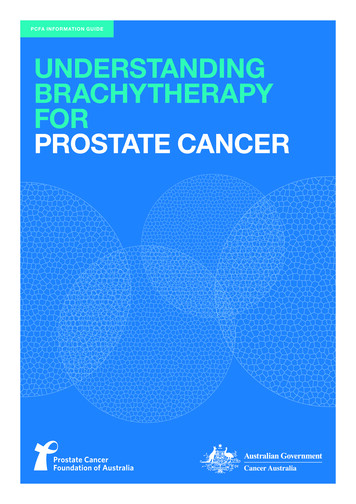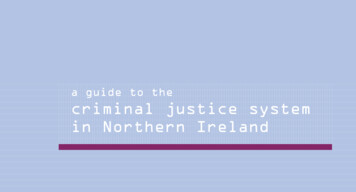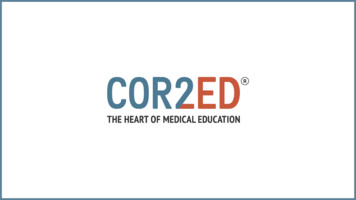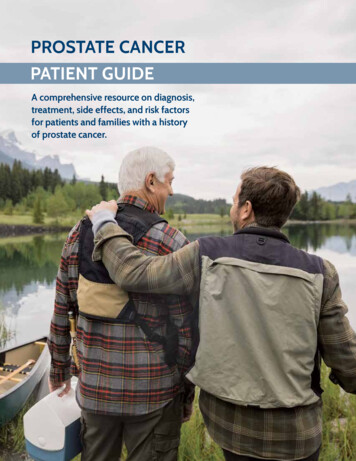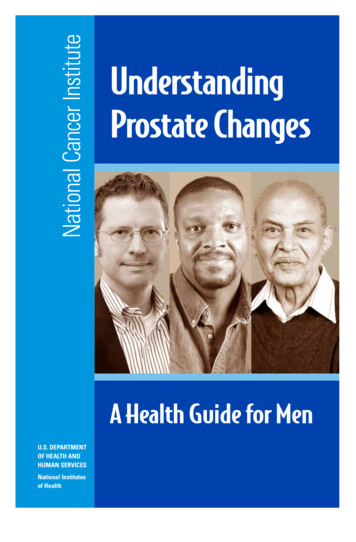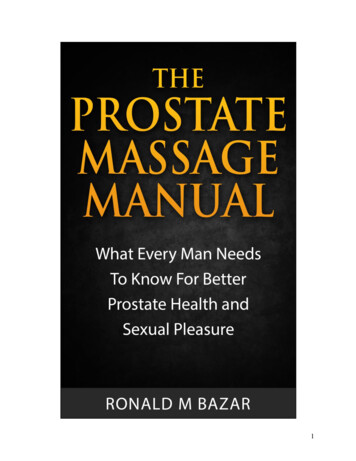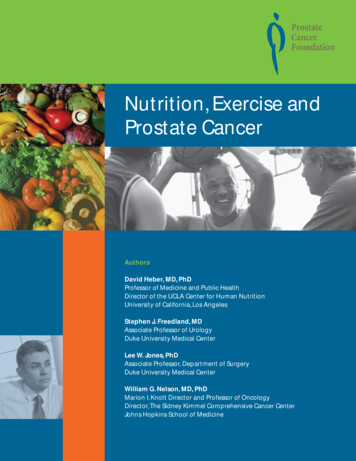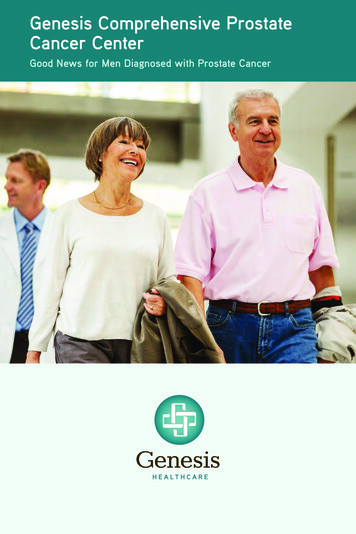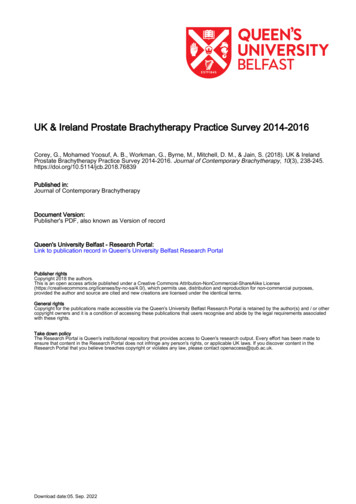
Transcription
UK & Ireland Prostate Brachytherapy Practice Survey 2014-2016Corey, G., Mohamed Yoosuf, A. B., Workman, G., Byrne, M., Mitchell, D. M., & Jain, S. (2018). UK & IrelandProstate Brachytherapy Practice Survey 2014-2016. Journal of Contemporary Brachytherapy, 10(3), ished in:Journal of Contemporary BrachytherapyDocument Version:Publisher's PDF, also known as Version of recordQueen's University Belfast - Research Portal:Link to publication record in Queen's University Belfast Research PortalPublisher rightsCopyright 2018 the authors.This is an open access article published under a Creative Commons Attribution-NonCommercial-ShareAlike -sa/4.0/), which permits use, distribution and reproduction for non-commercial purposes,provided the author and source are cited and new creations are licensed under the identical terms.General rightsCopyright for the publications made accessible via the Queen's University Belfast Research Portal is retained by the author(s) and / or othercopyright owners and it is a condition of accessing these publications that users recognise and abide by the legal requirements associatedwith these rights.Take down policyThe Research Portal is Queen's institutional repository that provides access to Queen's research output. Every effort has been made toensure that content in the Research Portal does not infringe any person's rights, or applicable UK laws. If you discover content in theResearch Portal that you believe breaches copyright or violates any law, please contact openaccess@qub.ac.uk.Download date:05. Sep. 2022
Review PapersReview paperUK & Ireland Prostate Brachytherapy PracticeSurvey 2014-2016Gemma Corey, MRCP FRCR1, A.B. Mohamed Yoosuf, MSc2, Geraldine Workman, MSc2, Monica Byrne, MSc2,Darren M. Mitchell, MD1, Suneil Jain, MD, PhD1,31Departmentof Clinical Oncology, Northern Ireland Cancer Centre, Belfast City Hospital, 2Department of Radiotherapy Medical Physics,Northern Ireland Cancer Centre, Belfast City Hospital, 3Queens University, Belfast, Antrim, Northern Ireland, UKAbstractPurpose: To document the current prostate brachytherapy practice across the UK and Ireland and compare withpreviously published audit results.Material and methods: Participants from 25 centers attending the annual UK & Ireland Prostate BrachytherapyConference were invited to complete an online survey. Sixty-three questions assessed the center’s experience andstaffing, clinician’s experience, clinical selection criteria and scheduling, number of cases per modality in the preceding three years, low-dose-rate (LDR) pre- and post-implant technique and high-dose-rate (HDR) implant technique.Responses were collated, and descriptive statistical analysis performed.Results: Eighteen (72%) centers responded with 17 performing LDR only, 1 performing HDR only, and 6 performing both LDR and HDR. Seventy-one percent of centers have 10 years of LDR brachytherapy experience, whereas71% centers that perform HDR brachytherapy have 5 years of experience. Thirteen centers have 2 or more cliniciansperforming brachytherapy with 61% of lead consultants performing 25 cases (LDR HDR) in 2016. The number ofimplants (range), that includes LDR and HDR, performed by individual practitioners in 2016 was 50 by 21%, 25-50 by38%, and 25 by 41%. Eight centers reported a decline in LDR monotherapy case numbers in 2016. Number of center’sperforming HDR brachytherapy increased in last five years. Relative uniformity in patient selection is noted, and LDRpre- and post-implant dosimetry adheres to published quality guidelines, with an average post-implant D90 of 145 Gyin 69% of centers in 2014 and 2015 compared to 63% in 2016. The median CT/US volume ratios were 0.9 1.0(n 4), 1.0 1.1 (n 7), and 1.1 (n 2).Conclusion: There is considerable prostate brachytherapy experience in the UK and Ireland. An apparent fall inLDR case numbers is noted. Maintenance of case numbers and ongoing compliance with published quality guidelinesis important to sustain high quality outcomes.J Contemp Brachytherapy 2018; 10, 3: 238–245DOI: https://doi.org/10.5114/jcb.2018.76839Key words: LDR prostate brachytherapy, HDR prostate brachytherapy, UK & Ireland.PurposeLow-dose-rate (LDR) permanent seed and high-doserate (HDR) temporary source brachytherapy are well recognized and effective treatment options for selected patientswith localized prostate cancer of any risk group [1,2,3,4,5,6].Brachytherapy as monotherapy or combination with external beam radiotherapy (EBRT) have demonstrated excellent results and improved biochemical outcomes whencompared with EBRT monotherapy alone [7,8,9]. Ongoingdevelopments with multi-modality imaging (US/CT/MRI)and adaptive treatment planning allows dose distributionsto be calculated and updated in real time based on the clinical requirements [10]. Despite this, the use of brachytherapy across the world has been in decline over the last decadepossibly due to broadening surgical practice, improvedconvenience of hypo-fractionated EBRT, and fewer residents in brachytherapy training programs [1,11,12].The aim of this survey is to document the currentprostate brachytherapy practice across UK and Ireland ascompared to the previous Royal College of Radiologist’s(RCR) Audit in 2012, where possible [13]. Further, wewished to assess the application of standards as set outin RCR guidance and other international publications onquality assurance [2,3,4,5,6].Material and methodsCenters attending the UK & Ireland Prostate Bra chytherapy Conference (Belfast, 2017) were invited tocomplete (one response per department) an online survey(Survey Monkey ).Address for correspondence: Ahamed Badusha Mohamed Yoosuf, MSc, MIPEM, Clinical Scientist,Department of Radiotherapy Medical Physics, Northern Ireland Cancer Centre, Belfast City Hospital,51 Lisburn Road, Belfast BT9 7AB, United Kingdom, e-mail: ahamed.badusha@belfasttrust.hscni.netReceived: 19.01.2018Accepted: 18.04.2018Published: 30.06.2018Journal of Contemporary Brachytherapy (2018/volume 10/number 3)
UK & Ireland Prostate Brachytherapy Practice Survey 2014-2016239Sixty-three questions were grouped into six themedsections as follows:1. Centre’s experience and staffing.2. Consultant experience, clinical selection criteria andscheduling: number of implants per practicing consultant (banded as 25, 25-50, and 50), clinical selection demographics, treatment scheduling, and follow-up arrangements.3. Number of cases treated in the preceding 3 years(banded into 0-15, 15-25, 25-50, and 50).4. LDR pre-implant technique: imaging/contouring,implant details, source strength, average number ofseeds/needles, treatment planning (TP) objectives,and constraints.5. LDR post-implant technique: imaging/contouring,prostate D90, room monitoring, and seed loss.6. HDR implant technique: imaging/contouring, implant type, image registration, prescription dose, TPobjectives, achieved dosimetry (V100%), and in-vivodosimetry.Responses were collated, and descriptive statisticalanalysis performed.ResultsCentre’s experience and staffingEighteen (72%) of 25 invited centers responded within the timeframe. Seventeen centers perform LDR permanent seed implantation compared to 15 in 2012, and 7 canters perform HDR prostate implant compared to 3 in2012 [13]. Six centers perform both LDR and HDR implants as opposed to 7 in 2012, and 1 center performsHDR implantation only. Twelve (of 17) centers perform-ing LDR brachytherapy have more than 10 years’ experience, and 5 (of 7) centers carrying out HDR implantationhave more than 5 years’ experience. One center has lessthan 1-year HDR brachytherapy experience, whilst 2 centers have over 15 years’ experience.The RCR’s quality assurance (QA) practice guidelines for LDR permanent seed brachytherapy recommenda minimum of 2 radiation oncologists and 2 medical physics experts (MPE) on each brachytherapy team to ‘ensureservice resilience’ [6]. Table 1 shows the current reportedstaffing levels. Thirteen (76%) centers have 2 or more implanting consultants, and 15 (88%) centers have 2 or moremedical physics experts as opposed to 25 centers in 2012that had 2 or more clinical oncologists and MPEs [13].Clinical and patient selection criteriaNumber of implants per consultant (2016)RCR guidelines recommend a minimum workload of25 cases (LDR HDR) per clinical oncologist (CO) peryear [6]. As shown in Table 2, 39% of centers reportedthat their leading consultants performed 25 cases in theyear 2016. Similarly, 38% and 50% centers reported thattheir 2nd and 3rd consultants have performed 25 cases in2016, respectively.Treatment schedulingTwelve centers perform LDR combination therapywith 7 centers performing EBRT pre- and 5 performingEBRT post-brachytherapy. Of the 7 centers performingHDR combination therapy, 5 centers perform the HDRimplant pre- and 2 centers carry out the HDR implantpost-EBRT.Table 1. Brachytherapy staff numbers in UK and Ireland 2017Staff memberNo of respondents(total n 18)Number of staff per center (whole time equivalent)123 3Implanting consultants185742Medical physics expert183951Clinical scientist160565Therapy radiographers132254Physics trainees158322Clinical trainees64101UK – United KingdomTable 2. Number of implants (low- high-dose-rate) performed by each consultant (2016)StaffNo of respondents(total n 18)Number of implants performed in the year 2016 25 25-50 50Consultant 118774Consultant 213553Consultant 36321LDR – low-dose-rate, HDR – high-dose-rateJournal of Contemporary Brachytherapy (2018/volume 10/number 3)
Gemma Corey, A.B. Mohamed Yoosuf, Geraldine Workman, et al.240Patient selection criteria for low-dose-rate prostatemonotherapyThe responses from centers on patient selection andcriteria for LDR prostate monotherapy based on variousfactors are reflected in Table 3. Hormonal manipulationalong with LDR treatments was used in 56% of centers inselected cases for either cyto-reduction prior to implantor as an adjuvant therapy for tumor management. Current data is compared to previous published surveys.Clinical follow-upClinical follow-up post-therapy is performed by oncology in 9 centers, shared care in 6 centers, and 1 centeroffering radiographer led follow-up alone.Number of cases treated in 2014-2016The number of cases treated during 2014-2016 is presented in Table 4, collected using banded groups: 15 cases,Table 3. Clinical selection criteria for low-dose-rate prostate monotherapy – comparison of current surveywith previous American Brachytherapy Society Surveys (1998 and 2012)CriteriaPrestidge et al. [14]Buyyounouski et al. [15]Current studyRespondents (%)Respondents (%)Respondents (%)(n 35)(n 63)(n 17)612 (37)17 (27)–712 (37)40 (63)15 (88)85 (14)5 (8)1 (6)96 (17)1 (2)1 (6)(n 35)(n 60)(n 17)T12 (6)5 (8)–T231 (88)53 (89)15 (88)T3A2 (6)2 (3)2 (12)(n 35)(n 59)(n 15)3 (9)/5 (14)–/4 (7)–5011 (31)6 (10)4 (27)6013 (37)31 (53)7 (46)3 (9)18 (30)4 (27)(n 35)(n 59)(n 17) 1011 (31)23 (39)2 (12) 1510 (29)20 (34)8 (47) 208 (23)15 (25)6 (35) 205 (14)1 (2)1 (6)(n 35)(n 63)(n 15)Not a contradiction/not considered12 (34)8 (12)5 (33)Relative contradiction19 (54)52 (83)6 (40)Absolute contradiction4 (11)3 (5)4 (27)(n 35)(n 0)(n 16)94%–9 (56)–7 (44)Gleason score; number of respondentsMaximum T stage; number of respondentsMaximum prostate size in cc;number of respondents30/40 60Maximum PSAPrevious TURPHormonal manipulationYesNoPSA – prostate specific antigen, TURP – transurethral resection of the prostate, cc – cubic centimeterJournal of Contemporary Brachytherapy (2018/volume 10/number 3)
UK & Ireland Prostate Brachytherapy Practice Survey 2014-201615-35 cases, 35-50 cases, 50-75 cases, and 75 cases peryear.Low-dose-rate pre-implant techniqueImplant type and prescription doseThe majority (14 of 17 centers) perform LDRbrachytherapy as a ‘real-time’ implant, and 3 centers perform a ‘two-step procedure’. All 17 centers use 125I seeds,and 1 center also uses 103Pd and 131Cs. A prescription doseof 145 Gy for LDR monotherapy is used in 13 (76%) centers241compared with 95% in the 2012 audit [13]. Four centersuse a prescription dose of 160 Gy. For LDR combinationwith EBRT, the prescription dose was 110 Gy in 100% ofcenters in 2012. However, in 2014-2016 it is reported as: in8 centers – 110 Gy, 2 centers – 106 Gy, 2 centers – 107 Gy,1 center – 115 Gy, and 1 center did not specify.Imaging and contouringThe most common imaging modality is ultrasound(USS), used by 65% of centers for the pre-treatment vol-Table 4. Number of cases treated between 2014 and 2016TechniquesRespondents(total n 18)No of cases treated 15 15-35 35-50 50-75 75LDR �–––201533––––201633––––LDR boost EBRTLDR focalLDR salvageHDR boostHDR monoHDR salvageLDR – low-dose-rate, HDR – high-dose-rate, EBRT – external beam radiation therapyJournal of Contemporary Brachytherapy (2018/volume 10/number 3)
Gemma Corey, A.B. Mohamed Yoosuf, Geraldine Workman, et al.242Table 5. Planning objectives used by all centersDosimetricobjectives andconstraintsObjective (numberof respondents)Number ofrespondents 99.8%1ProstateV100% (n 17) 99.5%1 99%5 98%2 95%8Treatment planning, seed placement, and sourcestrengthTreatment planning (TP) is carried out by a physicistor dosimetrist in all the centers. During the implant, theultrasound is operated by the oncologist (n 9) or urologist (n 9), radiologist (n 5) or physicist (n 1).The majority of centers (n 10) use stranded seedplacement, 1 center uses a variation of all 4 placementsincluding stranded, preloaded, loose, and Mick applicators. Seven centers use loose seeds for calibration, 5 usestrands, and 1 center uses both. Most centers use a reference air kerma rate (RAKR) of 0.5-0.6 U (n 12) or 0.4-0.5 U(n 11), and 1 center uses a RAKR of 0.7 U.The mean number of needles used are 23 ( 5) andmean number of seeds are 72 ( 9) per LDR monotherapyimplant, although this is RAKR dependent. The averagenumber of needles and seeds per unit volume (cc) is 0.85( 0.5) and 1.9 ( 0.5), respectively.CTVV100% (n 9) 95%7Don’t grow CTV1CTV prostate1 70%2 65%2ProstateV150% (n 15) 60%2 55-65%155-60%1 55%1 50%140-65%1 70%1 65%1Planning objectives and independent dose calculationverificationCTVV150% (n 8) 50%4Don’t grow CTV1CTV Prostate1 130%5The objective for prostate V100% is 99% at 7 centers, 98% at 2, and 95% at 8 centers. Seven centers requirea clinical target volume (CTV) V100% of 95%. Fifteencenters report V150% to the prostate and 8 centers reportV150% to a CTV. D30% to the urethra is reported by 11 centers and the majority aim for 130% of prescribed dose.D10% is reported by 8 centers, with the majority aimingfor 150%. The majority of centers (n 11) report a limitfor D2cc rectum as 145 Gy. A variety of constraints forprostate, CTV, urethra, and rectum were applied duringtreatment planning as shown in Table 5.UrethraD30% (n 11) 150%3 181 Gy2 240 Gy1 150%7 165%1V150% (n 1) 0 cc1V140% (n 1) 5% of the volume1 5%2D10% (n 8)Post-implant dosimetryRectumV100% (n 6) 0.4 cc1 0.9 cc1 1 cc1 1.3 cc1D2cc (n 10) 145 Gy10D0.1cc (n 3) 200 Gy3V69% (n 1) 2.6 cc1V91% (n 1) 1 cc1ume study. Multiple modality imaging is used in 4 centers and 1 center uses MRI. Pre-treatment contouring isperformed by the oncologists (38%), radiologists (13%),radiographers (13%), urologists (19%), and others (19%),which includes physicists. Image registration/fusion isused in 3 centers.CTV – clinical target volume, Vx% – volume receiving x% of the prescribed dose,Dxcc – dose received by x cc of the volume, Dx% – dose received by x% of thevolume, Gy – Gray, cc – cubic centimeterPost-implant CT scans are routinely performed in allcenters compared with 77% in 2012 [13]. Ninety-four percent (n 16) perform the scan 4-6 weeks later, and onecenter on day 0/day 1. Similar to the pre-implant contouring, the oncologist performs the majority (n 10) ofthe post-implant contouring followed by radiographers(n 4), and others such as the radiologist, physicist, anddosimetrist (n 3). Thirteen centers perform routine calculation of the CT/ultrasound volume. The median CT/US volume ratios were 0.9 1.0 (n 4), 1.0 1.1 (n 7),and 1.1 (n 2). Three centers routinely perform imageregistration or fusion in post-implant dosimetry, and sector analysis is performed by 4 centers.The average prostate D90 (Gy) achieved over the period 2014-2016 is displayed in Table 6. Sixty-nine percent of the centers reported average D90 145 Gy in theyears 2014 and 2015, whereas 63% of the centers achieved 145 Gy in 2016.Journal of Contemporary Brachytherapy (2018/volume 10/number 3)
UK & Ireland Prostate Brachytherapy Practice Survey 2014-2016243Table 6. Post-implant average D90 for the three-year period (2014-2016)YearNo of respondentsPost-implant D90 145 Gy 145-155 Gy 155-170 Gy 170 Gy2014165 (31%)3 (19%)6 (37%)2 (13%)2015165 (31%)3 (19%)7 (44%)1 (6%)2016166 (37%)2 (13%)4 (25%)4 (25%)D90 – dose to 90% of the prostate volume, Gy – GrayPost-procedure radiation protection room monitoring is usually performed by a nurse or physicist. Average seed loss, whereby seeds implanted were not seen onpost-implant dosimetry, was 3 per year in the majorityof centers, 2 centers had seed loss 3, but 10 seeds peryear based on number of seeds implanted versus numberidentified on the post-implant CT.High-dose-rate brachytherapy techniqueOf the 6 centers performing HDR monotherapy, 5 centers prescribe 19 Gy to 100% isodose volume and ensurethat 95% of planning target volume (PTV) is encompassedby the 100% isodose, whereas 1 center prescribes 19 Gy to90% of prostate volume. The definition of CTV was notacquired in this survey, although the GEC/ESTRO recommendations define CTV as the prostate capsule plusany macroscopic extracapsular disease or seminal vesicle involvement expanded by 3 mm, constrained by theanterior rectal wall and bladder base [5]. Seven centersreport HDR boost doses of 15 Gy; 5 centers prescribingto 100% isodose volume and 2 centers to 90% prostatevolume. Salvage therapy is performed by 4 centers, with2 centers prescribing 15 Gy to 100% isodose volume, andthe others prescribing 19 Gy to 100% isodose volume or90% of prostate volume.Although none of the centers performed focal therapyduring the 3-year period, 1 center suggested that the pre-scription dose would utilize a focal boost of 21 Gy to thedominant lesion and 15 Gy to the non-dominant prostaticPTV (although definition of same not provided). Detailsof cases numbers are detailed in Table 4.In all but 1 center, the oncologist performs the pretreatment contouring, with the other done by the radiologist. Ultrasound guidance is used in all centers forimplants and routine QA is performed in all centers;5 centers use metal needles and 2 use plastic needles, andmost centers report an average of 15-20 needles per implant.Three centers utilize image registration (US and MRI).The average percentage of the target volume receiving 100% of the dose (V100%) is 95-98% in 4 centers, 95%in 1 center, and 98-100% in 2 centers. Independent dosecalculation verification is carried out in all centers. Onecenter performs in vivo dosimetry measurements usingMOSFET detectors.Comparison with 2012 RCR ProstateBrachytherapy AuditTable 7 includes the current standards, where comparable to the standards achieved in the 2012 Audit [13].Discussion and conclusionWhilst the current survey had fewer responses thanthe RCR 2012 audit, we believe it is an accurate represen-Table 7. 2014-2016 reported standards compared to the 2012 RCR Survey StandardsRCR standardrecommendationsRCR targetStandard achieved (2012)respondents %Standard reported2014-2016respondents %1Each department should carryout at least 25 cases/year [15]100%100%71% centers treated 15 casesof LDR in 20162Each CO should carry outat least 5 cases/year [15]100%95%Not recorded in current surveybut 59% CO carry out at least25 cases/year3Dose prescribed for LDRshould be 145 Gyfor monotherapyand 110 Gy for boosts [5,6]100%95% – monotherapy76% – 145 Gy monotherapy24% – 160 Gy monotherapy64% – 110 Gy as boost4PID should be carried out[6,16,17]95%95%77% routinely100%5PID should be carried outat day 30 [17]90%32%94% – 4-6 weeks6% – day 0/16Dose to OAR should beassessed [16,17]90%95% – 1 organ32% – 2 organs88% reported tolerancesfor 2 organs100% – boostRCR – Royal College of Radiologists, CO – clinical oncologist, LDR – low-dose-rate, PID – post-implant dosimetry, OAR – organs at risk, Gy – GrayJournal of Contemporary Brachytherapy (2018/volume 10/number 3)
Gemma Corey, A.B. Mohamed Yoosuf, Geraldine Workman, et al.244tation of prostate brachytherapy practice in the UK andIreland, documenting the evolution in techniques andcase numbers over the preceding 3 years. There is a clearfocus on maintaining high quality implants, as evidencedby the reported D90’s and the universal use of the 3 keyRCR QA markers in LDR of D90, CT/US volume ratio,and V100 across responding centers.We note a number of centers reporting a reductionin LDR cases from 2014 to 2016 either as monotherapyor as combination therapy [1,2,3,4,5,6,7,8,9,10,13,18,19].ASCENDE RT showed that men treated with LDR boostwere twice as likely to be biochemically failure-free whencompared to EBRT alone, was only presented in February2015 at GU ASCO, and thus may not have impacted practice immediately [20]. However, it is also possible thatthe companion paper on toxicity could have negated theimpact of this important study [21]. The continuous improvement in planning technology and review of expansion margins may help to reduce the potential of longterm urinary toxicity in combination cases, whilst hopingto maintain the biochemical benefit over EBRT alone.The number of LDR boost treatments overall is modest. Robotic radical prostatectomies, improving convenience of hypo-fractionated EBRT for low- to intermediate-risk disease, following the CHHiP trial publication,and research interests in stereotactic radiotherapy arecompeting treatment options that may have impacted onreferral practice [22,23,24].HDR brachytherapy boost numbers appear to be increasing with more centers offering this modality in thelast 5 years. Whilst the procedure time is longer, the radiobiological advantages, improved USS-based planningsoftware, reduced reliance on operator skill, and potential consumable cost saving may have contributed to thelimited impact of ASCENDE RT on the number of LDRboosts being performed. This cohort of high tier intermediate and high-risk cases are perhaps now directed toward HDR combined with EBRT with its own supportingevidence base [25,26].The number of implants performed by individual consultants is noteworthy. Firstly, based on the RCRguidance, consultants are encouraged to perform at least25 cases per year, our survey shows that 41% of implanting consultants in 2016 carried out less than this number. This may be due to the apparent fall in LDR casesreported by some centers in our survey or to an increasing number of implanting consultants individually performing fewer cases. The 2012 Audit reported that 100%of centers performed 25 cases per year, although specific numbers per consultant was not documented but95% of consultants performed at least 5 implants per year[12]. Secondly, the RCR guidelines suggest that in orderto mentor a trainee in brachytherapy, the mentor shouldbe performing 100 implants over the preceding 3-yearperiod. Our survey therefore suggests that the potentialmentor cohort based on this guidance is modest. Traineesmay therefore have limited exposure to brachytherapy,as has been reported in the US [26]. Reduced trainee experience and exposure to prostate brachytherapy couldshrink the collegiate knowledge of patient selection andthe procedure, leading to a reduced referral rate.This survey was limited by the lower number of responses received from institutions (n 18) than the previous 2012 RCR audit (n 29). It is unclear if this representsfailure to respond or if there has been a true reduction inthe number of centers offering brachytherapy and consolidating their cases to higher volume centers. This couldbe answered by repeating the RCR audit using the samemethodology as in 2012 and adapting our survey questionnaire. We recognize that the information gained inthis survey would have been enhanced by asking for theabsolute number of cases per year, their referral sources,and the specific prescription points used for the dosimetric variables, including target volume definitions andexpansion margins used.Pleasingly, our survey shows that all brachytherapyteams are continually reviewing and assessing implantquality by performing post-implant dosimetry in 100%of cases, and as an adaptive process may identify andadjust parameters for their center that maintain and improve dosimetric quality, biochemical, and toxicity outcomes.For men with localized prostate cancer, LDR/HDRmonotherapy or EBRT combined with LDR/HDR boostprovides excellent biochemical outcomes [1], and several studies have reported superior outcomes, reducedtoxicities, and excellent quality of life at a low-cost fromeither form of brachytherapy when compared to othertreatments. Prostate brachytherapy offers suitable menan outstanding opportunity to achieve a high-dose, precisely targeted, and convenient treatment with excellentbiochemical outcomes entsWe gratefully acknowledge the staff from eighteencenters that responded to this survey. We also thankRight Angle Communications for assistance with surveydissemination and collection of results and to IPEM forinclusion of survey website in their Newsletter.This work has been submitted as a summary in theIPEM Scope Magazine, United Kingdom (2017). Thiswork has been submitted as an abstract at the ASCO-GU(American Society of Clinical Oncology – Genitourinary)Symposium (2018). This work has been submitted as anabstract at the ESTRO (European Society for Radiotherapy & Oncology) conference (2018).DisclosureThe authors report no conflict of interest.References1. Zaorsky NG, Davis BJ, Nguyen PL et al. The evolution ofbrachytherapy for prostate cancer. Nat Rev Urol 2017; 14:415-439.2. Davis BJ, Horwitz EM, Lee WR et al. American BrachytherapySociety consensus guidelines for transrectal ultrasound-guided permanent prostate brachytherapy. Brachytherapy 2012;11: 6-19.3. Yamada Y, Rogers L, Demanes DJ et al. American Brachytherapy Society consensus guidelines for high-dose-rate prostatebrachytherapy. Brachytherapy 2012; 11: 20-32.Journal of Contemporary Brachytherapy (2018/volume 10/number 3)
UK & Ireland Prostate Brachytherapy Practice Survey 2014-20164. Salembier C, Lavagnini P, Nickers P et al. Tumour andtarget volumes in permanent prostate brachytherapy: a supplement to the ESTRO/EAU/EORTC recommendations onprostate brachytherapy. Radiother Oncol 2007; 83: 3-10.5. Hoskin PJ, Colombo A, Henry A et al. GEC/ESTROrecommendations on high dose rate afterloading brachytherapy for localised prostate cancer: an update. Radiother Oncol2013; 107: 325-332.6. The Royal College of Radiologists: Quality AssurancePractice guidelines for transperineal LDR permanent seedbrachytherapy of prostate cancer. The Royal College of Radiologist, London 2012.7. Zaorsky NG, Shaikh T, Murphy CT et al. Comparison of outcomes and toxicities among radiation therapy treatment options for prostate cancer. Cancer Treat Rev 2016; 48: 50-60.8. Hoskin PJ, Rojas AM, Bownes PJ et al. Randomised trial ofexternal beam radiotherapy alone or combined with highdose-rate brachytherapy boost for localised prostate cancer.Radiother Oncol 2012; 103: 217-222.9. Spratt DE, Soni PD, McLaughlin PW et al. American Bra chytherapy Society Task Group Report: Combination of bra chytherapy and external beam radiation for high-risk prostate cancer. Brachytherapy 2017; 16: 1-12.10. Lee CD. Recent Developments and best practice in brachytherapy treatment planning. Br J Radiol 2014; 87: 20140146.11. Petereit DG, Frank SJ, Viswanathan AN et al. Brachytherapy:where has it gone? J Clin Oncol 2015; 33: 980-982.12. Copperberg MJ, Broering JM, Carroll PR. Time trends andlocal variation in primary treatment of localised prostate cancer. J Clin Oncol 2010; 28: 1117-1123.13. Stewart AJ, Drinkwater KJ, Laing RW et al. The Royal College of Radiologists’ Audit of Prostate Brachytherapy in theYear 2012. Clin Oncol 2015; 27: 330-336.14. Prestidge BR, Prete JJ, Buchholz TA et al. Survey of currentclinical practice of permanent prostate brachytherapy in theUnited States. Int J Radiat Oncol Biol Phys 1998; 40: 461-465.15. Buyyounouski MK, Davis BJ, Prestidge BR et al. A survey ofcurrent clinical practice in permanent and temporary prostate brachytherapy: 2010 Update. Brachytherapy 2012; 11:299-305.16. Crook J. Long-term oncologic outcomes of radical prostatectomy compared with brachytherapy-based approaches forintermediate- and high-risk prostate cancer. Brachytherapy2015; 14: 142-147.17. D’Amico AV, Whittington R, Malkowicz SB et al. Biochemical outcome after radical prostectomy, external beam radiation therapy or interstitial radiation therapy for clinicallylocalized prostate cancer. JAMA 1998; 280: 969-974.18. Royal College of Radiologists. The role and development ofbrachytherapy services in the United Kingdom. Royal College of Radiologists, London 2007.19. Zaorsky NG, Doyle LA, Yamoah K et al. High dose ratebrachytherapy boost for prostate cancer: a systematic review.Cancer Treat Rev 2014; 40: 414-425.20. Morris WJ, Tyldesley S, Rodda S et al. Androgen Supp
Jour ontemporar achytherap Review Papers Review paper UK & Ireland Prostate Brachytherapy Practice Survey 2014-2016 Gemma Corey, MRCP FRCR1, A.B. Mohamed Yoosuf, MSc2, Geraldine Workman, MSc2, Monica Byrne, MSc2, Darren M. Mitchell, MD1, Suneil Jain, MD, PhD1,3 1Department of Clinical Oncology, Northern Ireland Cancer Centre, Belfast City Hospital, 2Department of Radiotherapy Medical Physics,
